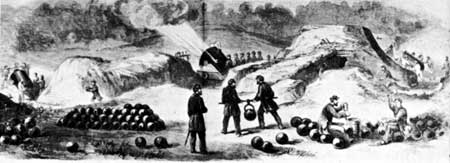|
FORT PULASKI National Monument |
 |
Surrender
On Friday morning, at daylight, the bombardment reopened with fresh vigor on both sides. Pulaski had repaired some of her guns during the night and now directed her barbette fire with considerable precision and rapidity. From Tybee, Gillmore's gunners resumed the work of breaching with determination, and the effect was almost immediately apparent in the enlargement of the two embrasures on the left of the southeast face of the fort. Pulaski's fire was far less accurate than that of the Federals. The batteries on Tybee were nearly all masked behind a low sand ridge and were also protected by heavy sandbag revetments. Most of the Confederate shot and shell buried themselves in the beach or traveled completely over the Federal batteries and trenches. About 9 o'clock the besiegers received their only casualty. A solid shot from Pulaski entered a gun embrasure in Battery McClellan striking a private soldier and wounded him so severely that he died soon after.
During the morning, the naval gunboat, Norwich, began to fire against the northeast face of the fort, but the range was too great and her shots struck only glancing blows on the brick walls. A battery on Long Island opened up at long range from the west, and shots were landing on the south wall from guns located on a barge in Tybee Creek.
At noon, a considerable part of the Federal fire was directed against the guns on the ramparts of the fort and within half an hour these guns were silenced. By now, two great holes had been opened through the walls and the inside of the fort was visible from Tybee. The interior arches had been laid bare, and a barbette gun on the parapet was tottering, ready to fall. It was plain that the whole east angle would soon be in ruins. General Benham gave orders to prepare to take Fort Pulaski by direct assault.
At the fort, when all men were ordered from the ramparts to allow the guns to cool, Pvt. L. W. Landershine thought that "things looked blue." One man had been mortally wounded, another had had his foot taken off by the recoil of a gun, and a dozen others had been struck by fragments of shell. Projectiles from the rifle batteries were passing completely through the breach, sweeping across the parade, and striking against the walls of the north magazine in which 40,000 pounds of black powder was stored.
The moment had come for Olmstead to make a decision. There were only two courses open. He could fight on against overwhelming odds, or he could admit defeat. It must have been a difficult choice for the gallant 25-year-old colonel to make. Impressed by the utter hopelessness of the situation and believing the lives of the garrison to be his next care, he gave the order for surrender.
Says Private Landershine, who was at this time discussing the state of affairs with his comrades, "About 2-1/2 p. m. I seen Col. Olmstead and Capt. Sims go past with a rammer and a sheet, we all knew that it was over with us and we would have to give up."

Mortar Battery Stanton in action, April 10, 1862.
Sketch by W. T. Crane in Supplement to Frank Leslie's Illustrated
Weekly, May 3, 1862.
The Confederate flag was lowered half way and a final gun was fired from a casemate. Then the flag was hauled down and the white sheet took its place. An old era in coastal fortifications had come to an end.
On Tybee there was wild rejoicing. Men danced together on the beach, shook hands, and cheered General Gillmore as he rode along the line. At King's Landing, Gillmore embarked on a small boat with his aides. The passage up the South Channel was rough, the skiff ran aground and was nearly swamped by the heavy seas. Soaked with the salt tides of the Savannah, the party landed at Cockspur Island and advanced toward the fort under a flag of truce. Colonel Olmstead was waiting at the entrance. He showed the way to his quarters, and, during an hour alone with General Gillmore, the terms of the capitulation were settled. After inspecting the fort, the general took leave.
In Colonel Olmstead's quarters by the half-light of candles, the officers of the fort gave up their swords to General Hunter's representative, Maj. Charles G. Halpine. The weapons were laid on a table, and each officer, according to his rank, advanced in turn, mentioned his name and title, and spoke a few words appropriate to the occasion. Said Colonel Olmstead, "I yield my sword, but I trust I have not disgraced it."
The men of the garrison were formed by companies on the parade, stacked their arms, and marched to quarters for the night. The Stars and Stripes was then raised over the ramparts, and Pulaski again became part of the possessions, as well as the property, of the Union.
Terms of the surrender were unconditional.

|

|
|
Last Modified: Mon, Mar 4 2002 10:00:00 pm PDT |


